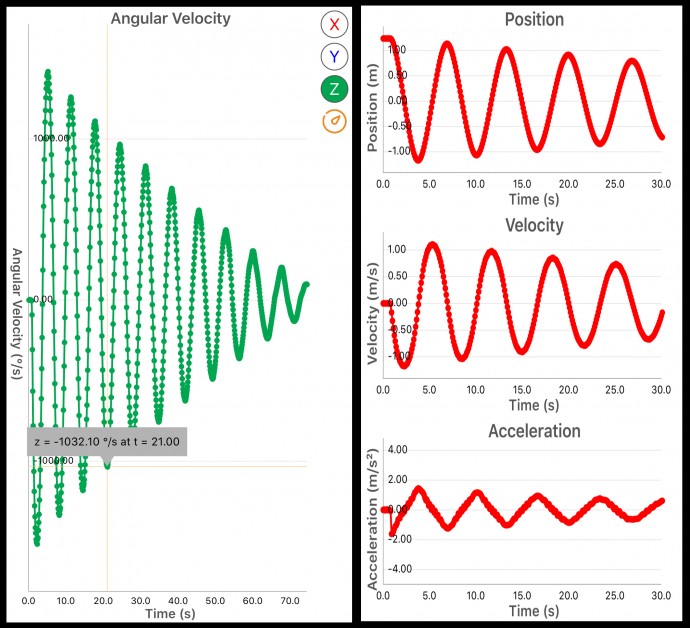Introduction
Don't discard your school's empty 3D filament reels. There's a good chance that you and your students could come up with some interesting physics lab investigations using these reels. Attach Voyager or PocketLab One to the reel and the possibilities are endless! This lesson describes a unique experiment in which periodic motion is investigated using an empty 3D filament reel. Depending on the teacher's goals and amount of detail in the analysis of collected data, this lab could be used from the 4th grade through high school. The only things required, in addition to the usual lab furniture, are about 12 feet of 2¼" adding machine tape, some masking tape, and an empty 1-kg 3D filament reel. See Figure 1 for a close up of the reel with Voyager attached.

Periodic Motion Lab Setup
Figure 2 shows the setup for this periodic motion lab using an empty 3D filament reel. The top half of the figure shows a roughly 12 foot piece of 2¼" adding machine tape that has been taped to two chairs and hanging between the chairs. The bottom half of the figure shows an empty 3D filament reel at rest at its equilibirum position at the center of the adding machine tape.

If you just want your students to study angular velocity as the reel rolls back-and-forth on the tape, the PocketLab app would serve this purpose well. The z-axis is the axis of rotation that is of interest. This would be appropriate for 4th grade through junior high school students.
However, studying position, velocity, and acceleration of the reel as it moves back-and-forth on the tape provides a great opportunity for high school students to study the relationship between these three concepts in periodic motion. This is readily accomplished by using the VelocityLab app. In this case, the diameter set in the app would be the diameter of the circle that is in contact with the adding machine tape. With the reel at rest at its equilibrium position, i.e., the zero position setting in the app, carefully roll the reel to the far left of the tape without letting it slip. Then start data collection with the VelocityLab app and release the reel. A data collection rate of the default 10 points/second works well, and the z-axis is the axis of rotation that is of interest. Let the reel roll back-and-forth until it gets close to stopping.
Video
The video below shows a typical run of this periodic motion lab with Voyager on an empty 3D filament reel. The video shows VelocityLab displaying real-time position, velocity, and acceleration data as the reel moves back and forth.
Typical Results
Figure 3 shows graphs of typical data collected in this lab. The graph on the left shows angular velocity data collected by the PocketLab app. The graphs on the right show position, velocity, and acceleration data collected by the VelocityLab app.

Questions for Student Discussion
Questions on the Angular Velocity Graph
- Where is the reel located when the angular velocity is zero?
- Where is the reel located when the magnitude of the angular velocity is at local maxima?
- What is the period of the reel as it moves back-and-forth? Is the period constant or does it increase with passing time?
- How do the local maxima change with the passage of time? What are some possible reasons for this change?
- Why does the angular velocity alternate between negative and positive?
- What direction (to the right or to the left) is the reel moving when its angular velocity is negative? when it is positive?
Questions on the Position, Velocity and Acceleration Graphs
- What is the period of this motion in seconds? (Note that the period is the time for one complete back-and-forth oscillation. Period can be computed by determining the time between adjacent peaks in either position, velocity, or acceleration.) Is the period constant or does it appear to be increasing with the passage of time?
- When the reel is centered on the tape, what can be said about velocity and acceleration?
- Where is the reel located when the magnitude of the acceleration is at a local maxima?
- What can be said about the velocity when the magnitude of the acceleration is at a local maxima?
- Discuss the idea that the instantaneous slope of points on the position vs. time graph gives the velocity, and the instantaneous slope of points on the velocity graph gives acceleration.
- What direction (to the right or to the left) is the reel moving when its velocity is negative? when it is positive?
- How do the local maxima change with the passage of time? What are some possible reasons for this change?
- Is the damping of this periodic motion negative exponential? Provide evidence for or against negative exponential damping using spreadsheet data analysis.

